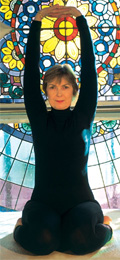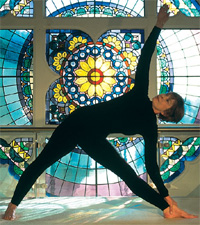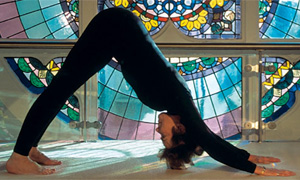Yoga helps posture, and aids the flow of body energy. Research carried in Cancer Watch has shown that it also reduces cancer-promoting stress hormones like cortisol; then the New York Presbyterian hospital showed that meditation prior to surgery could reduce blood loss by up to 40 per cent. Something very positive is going on, particularly for a person touched by cancer.

Penny Chaplin was a secretary and mother before taking up yoga, when she was 21, to help with the side effects of some of the medication she was taking for asthma.
She wanted to improve her health, her mental outlook and learn how to relax. She did all that and more; she found a new career.
Penny has been a yoga therapist and teacher for more than 30 years now, since studying with the creator of one of the most popular styles of yoga in the world, B.K.S. Iyengar. She teaches Iyengar yoga classes all over London, and trains other teachers, but feels a special empathy with the women who attend her weekly class at The London Breast Cancer Haven, as she had a lumpectomy herself in 1988.
Finding out about yoga can be a confusing business. Depending on who you speak to, or which books you read, you will see that there are many different schools of yoga, and the terminology and descriptions of the poses and stages also differ. What’s important though, for anyone living with cancer, is to practice yoga either in a class with a fully qualified teacher, who knows about your condition, or in one-to-one sessions with a remedial teacher. Yoga will help strengthen your body and mind, as well as helping you relax and deal with day-to-day stress.

Yoga will help strengthen your body and mind

Yoga is one of the six systems of Indian philosophy. It has been passed down orally, through the generations, until some time between the fifth and second century BC when a sage called Patanjali wrote about the subject in his treatise the Yoga Darnisha (also known as the Yoga Sutras of Patanjali), which forms the basic text of yoga.
The word itself means "union" or "integration". Union of the physical, physiological, mental, emotional and intellectual bodies; leading one to live an integrated, purposeful, useful and noble life. Now there’s something to aspire to...
Patanjali’s yoga sets out the eight aspects (astanga) of yoga as:

1 yama
2 niyama
3 asana
4 pranayama
5 pratyahara
6 dharana
7 dhyana and
8 samadhi
Yama and niyama are codes of moral and social conduct; asanas are adjusting the body in various postures with the complete involvement of the mind, awareness and intelligence; pranayama, the regulation and restraint of breath; pratyahara, relaxation and internalisation of the senses of perception; dharana, concentration; dhyana, meditation; samadhi, the ultimate state of self-realisation.
Of these, only the first four aspects can be taught. The next two, pratyahara and dharana are internal quests; while dhyana and samadhi concern the innermost quests of reaching a supreme, ultimate state of self-realisation, when the subject and object become one. So pratyahara, dharana, dhyana and samadhi are experimental states and can never be taught.
Over the centuries, several translations and commentaries have been written on these yoga sutras. B.K.S. Iyengar, a living authority on the subject, made it possible for people from all walks of life to experience the wisdom of the yoga sutras. His style of yoga is noted for great attention to detail and the precise alignment of postures. Iyengar teachers have to complete a rigorous two-to-five-year training programme before becoming fully qualified.

B.K.S. Iyengar has shown and taught how practising asanas and pranayama teaches you to concentrate on the subject of your choice.
How you can develop your discriminative faculty to differentiate the essential from the incidental, and thereby achieve not only physical poise but also mental peace, intellectual clarity and emotional calm. So by practising yoga a dancer can become a better dancer. One of Iyengar’s former pupils, violin maestro, Lord Yehudi Menuhin best exemplified this by acknowledging his guru not only as his best yoga teacher - but his best violin teacher.
Yoga and breast cancer Iyengar yoga therapist and teacher Penny Chaplin has classes all over London, but she used her wealth of experience to specially modify a weekly yoga class at The London Haven, (a welcoming support centre for people affected by breast cancer). "I’m very familiar with this territory, and the problems, because I was diagnosed with breast cancer in 1988," Penny explains. "It was difficult for me to come to terms with it, at that time, but my yoga teacher showed me how to work in yoga to help, but not overstrain myself, and how to deal with the stress of being diagnosed. I changed my diet, went to the Bristol Cancer Centre, gave up dairy products, and started juicing.
I had to fight for a lumpectomy, they wanted to do a mastectomy, and I go back for check-ups every six months. I think yoga gave me the strength to cope with it all."
Penny missed her yoga, while in hospital, and went back to teaching as soon as she came out.

Yoga can be very strenuous and dynamic

"Yoga can be very strenuous and dynamic," she says, "but I avoided certain asanas while I was recovering. I gear my classes at the Haven, accordingly, so that they are done in a recuperative style and there is not very much standing up. We work quietly there, and do a lot of postures to open up and stretch the breast and lymph areas."
Penny says that yoga can be of benefit whatever cancer you have, as long as you find a qualified teacher and inform them of your condition. "But I would not recommend Ashtanga yoga for cancer sufferers," she stresses. "It’s fine if you’re aged between 18 and 30, and are fit and healthy, but it is to be avoided otherwise, because it’s all jumping and people can injure their backs and knees.
Hatha yoga is the first step, then you move on to the pranayama (breathing) and then to the other steps and meditation. Learning the asanas is hard work, and a lot of people don’t want to go through those postures.
They want to sit and meditate. But how can you sit and meditate if you’ve got a back or knee ache? We feel that the body is your temple. It has to have a strong foundation before you move on. If you can’t staighten your leg or stand straight, how can you control your breathing? Once the body is strong and stable, we concentrate on the breath and then mind and control of energy into the body.
Yoga is the best exercise to keep your mobility after cancer treatment and give you strength, because of the way the postures work on the body. You lose a lot of your movement after having radiotherapy. I still have a lot because I did yoga before I was diagnosed, and I worked to maintain it, but even now there are poses I have to struggle with that I could do before," she admits.

Yoga is the best exercise to keep your mobility after cancer treatment

"People look at yoga from the outside, the shape you’re making, but every single movement works on a certain part of the body. A head balance really clears the mind; inversions work on the thyroid and pituitary glands; twists work on the kidneys and liver and cleanse the body, ridding it of toxins; standing poses strengthen the leg and back muscles; forward bends quieten your mind while back bends stimulate it and give you energy.
So if I’m teaching a general class, and they’re feeling tired and fed up, I can change their mood. I can do an hour of back bends and at the end I’ve got a totally different class".
The more you learn about yoga, the more you want to learn. It is a science, a discipline and a wonderful way to relax. As Penny says. "As you move on week after week and become more familiar with the asanas, you begin to understand how the body works. And then those poses in themselves lead you to stillness of the mind.
There are hundreds of poses and they cure headaches, backaches... The general everyday ailments that you go to the doctor with, where he’ll just say, ’Take and aspirin.’ Yoga also strengthens those with cancer because the poses are very dynamic and give you stability of the body and mind.
I believe that once you understand the poses, yoga is something you can carry with you through the rest of your life. You don’t need to go to a gym or anywhere special, but do it wherever you are, and it will give you tremendous strength."

Features Of Iyengar Yoga
It is suitable for all ages and cuts across geographical, lingual, social and economical barriers. Iyengar yoga is based on very strong standing asanas (poses). The emphasis is on precision and alignment in all postures, standing, sitting, twisting, inverted, forward or backward bending or supine postures. Students are taught to stay longer in each posture, to experience it.
Props, such as wooden gadgets, belts and ropes are used so that the practioner can strive to acheive perfection in the posture. These also help the elderly, incapacitated and disabled to perform and benefit from the classical postures - something they would never be able to do independently.
To find out more about classes at The London Haven (held entirely free of charge) between 2 - 3pm every Thursday, call the The London Haven on 0207 384 0099.
For details of other classes, call Penny on 020 7624 4287. Alternatively via email: [email protected].
If you wish to find out about Iyengar yoga classes in your area, or remedial ones, contact the Iyengar Yoga Institute on 020 7624 3080.